A record 8% of households with minor children in the United States are headed by a single father, up from just over 1% in 1960, according to a Pew Research Center analysis of Decennial Census and American Community Survey data.
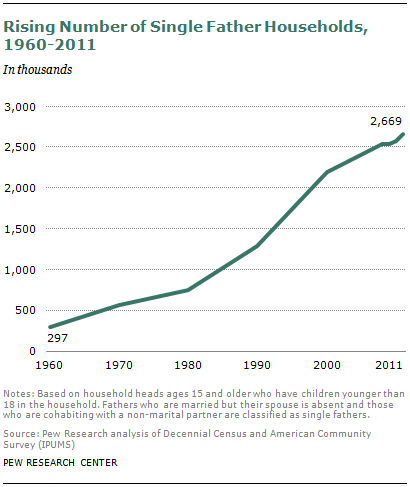
The number of single father households has increased about ninefold since 1960, from less than 300,000 to more than 2.6 million in 2011.1 In comparison, the number of single mother households increased more than fourfold during that time period, up to 8.6 million in 2011, from 1.9 million in 1960.
As a result, men make up a growing share of single parent householders.2 In 1960, about 14% of single parent households were headed by fathers, today almost one-quarter (24%) are.
There are some notable differences between single mothers and single fathers. Single fathers are more likely than single mothers to be living with a cohabiting partner (41% versus 16%). Single fathers, on average, have higher incomes than single mothers and are far less likely to be living at or below the poverty line—24% versus 43%. Single fathers are also somewhat less educated than single mothers, older and more likely to be white.
Compared with fathers heading households with two married parents, single dads are younger, less educated, less financially well-off and less likely to be white.
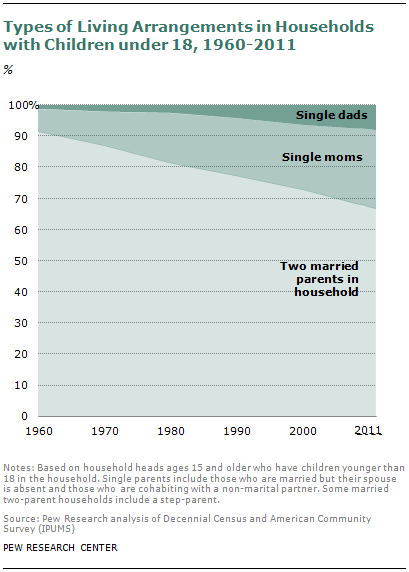
In this report, fathers include those men who are ages 15 or older, who are the head of their household, and who report living with their own minor children (biological children, step-children or adopted children). Fathers who are living in a household headed by someone else are excluded from the analysis, as are fathers whose children are not living with them.
The term ‘single father’ includes men in a variety of family circumstances. About half (52%) are separated, divorced, widowed or never married and are living without a cohabiting partner; some (41%) are living with a non-marital partner; and a small share (7%) are married but living apart from their spouse.3
Cohabiting single fathers are particularly disadvantaged on most socio-economic indicators. They are younger, less educated and more likely to be living in poverty than are fathers who are raising children without a spouse or partner in the household.
Overall, two-thirds (67%) of households with children are headed by two married parents; in 1960, this share was 92%.4
The increase in single father households is likely due to a number of factors, most of which have also contributed to the increase in single mother households, and to the decline of two-married-parent households.
First and foremost, there has been a marked increase in the share of non-marital births. And even though divorce rates have leveled off in recent decades, they remain higher than they were in the 1960s and 1970s. Some experts suggest that changes in the legal system have led to more opportunities for fathers to gain at least partial custody of children in the event of a breakup, as well.
At the same time, the role of fathers has evolved, and the public now acknowledges their importance not only as breadwinners, but also as caregivers. Analysis of long-term time use data shows that fathers are narrowing the still sizable gap with mothers in the amount of time they spend with their children. And Pew Research surveys find that the public believes that a father’s greatest role is to provide values to his children, followed by emotional support, discipline and income support. Public opinion ascribes roughly the same hierarchy of roles to mothers.
Profile of Single Father Householders
Like single mothers, single fathers are typically less educated and less well-off than their married counterparts. They are also younger and less likely to be white. However, single father householders differ from single mother householders on several indicators. Most notably, households headed by single fathers appear to be much better off financially when compared with those headed by single mothers.
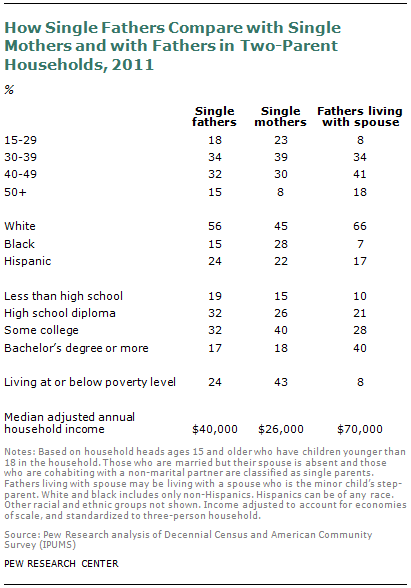
Single fathers are younger than married fathers, but older than single mothers. While just 8% of married fathers are younger than 30, this share is 18% for single fathers and 23% for single mothers. And at the other end of the age spectrum, fully 47% of single fathers are 40 years or older. This is the case for just 38% of single mothers and fully 59% of married fathers.
Single father householders are more likely to be white than single mother householders, but less likely to be white than married father householders. Just over half (56%) of single fathers are white, as are 45% of single mothers and two-thirds (66%) of married fathers. Single fathers are much less likely to be black—15% are—as compared with single mothers (28%), but more likely to be black than fathers in married two-parent households (7%). The share of single fathers that is Hispanic is close to the share among single mothers (24% and 22%, respectively), but is higher than the share among married fathers (17%).
The educational attainment of single father householders is markedly lower than that of married father householders. About one-fifth (19%) of single dads lack a high school diploma, while just 10% of married fathers lack one. Among single mothers, this share is 15%. Equally dramatic differences emerge at the other end of the education spectrum; just 17% of single fathers (and 18% of single mothers) have a bachelor’s degree, compared with 40% of married fathers.
In terms of household financial status, single fathers are much better off than single mothers, and much worse off than married fathers. Median adjusted annual income5 for a single dad household of three is about $40,000—a far cry from the $70,000 median among households headed by married fathers, but much higher than that of households headed by single mothers, where the median adjusted annual income for a three-person household is only $26,000.
The same pattern is reflected in poverty status across these household types. Almost one-fourth (24%) of single father households are living at or below the poverty level, compared with just 8% of married father households and fully 43% of single mother households.
Single Fathers are Younger, Less Educated
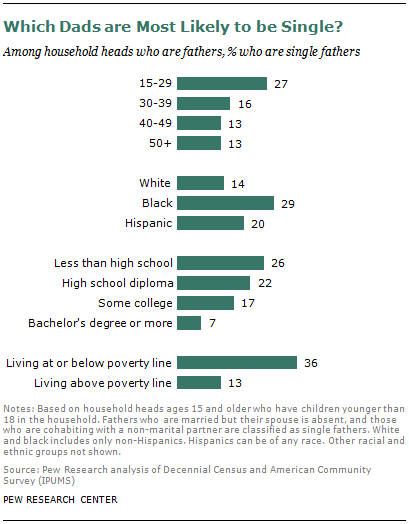
Among household heads who are fathers, some are more likely to be single dads than others. Single fatherhood is generally more prevalent among younger, less educated, poorer and non-white fathers.
Some 27% of fathers under the age of 30 are single fathers, and most of these are cohabiting. The share of fathers that are single fathers declines markedly at older ages—16% of those ages 30-39 are single fathers, and 13% of those ages 40 or older are. While the bulk of single fathers among younger men are cohabiting, the reverse is true for fathers ages 40 and older—most of these single fathers have no spouse or partner in their household.
Black fathers are the most likely to be heads of single father households—29% are. This share drops to 20% among Hispanic fathers and just 14% among white fathers.
The prevalence of single fatherhood is closely linked to educational level; the more education a father has, the less likely he is to head a single father household. While about one-fourth (26%) of fathers lacking a high school diploma are single fathers, the share drops to 22% for fathers with a high school degree. Among dads with some college, 17% are single fathers, and just 7% of fathers with a bachelor’s degree fall into this category.
Poverty is also linked with single fatherhood: More than one-third (36%) of fathers who are living at or below the poverty line are single parents. This share drops to 13% for those living above the poverty line.
DIFFERENT TYPES OF SINGLE DADS
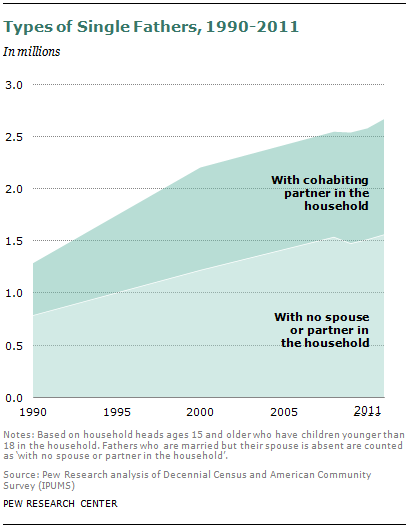
Since 1990, the Census Bureau has collected data not only on the marital status of household heads, but also information regarding whether the head was living with a non-marital partner. This allows for a further differentiation of single fathers—those who have no spouse or partner living with them and those who are cohabiting.6
About 59% fall into the first category; they have no spouse or partner in residence with them. In 1990, they numbered about 790,000 (61% of all single father households), and by 2011 that number had risen to almost 1.6 million. The remaining 41% of single father household heads are living with a partner. In 1990, about 498,000 single fathers were cohabiting (39% of single father households), and in 2011 that number had more than doubled to 1.1 million.
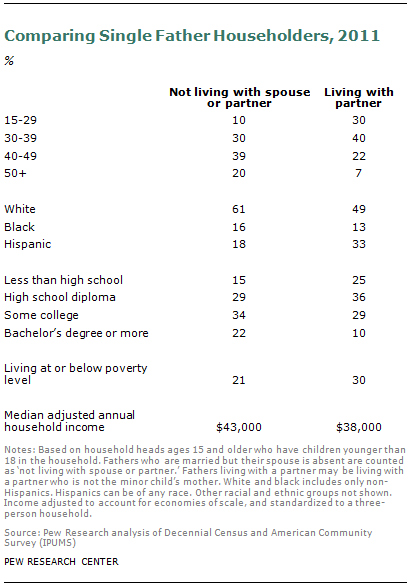
There are significant differences in the profiles of each of the single father groups. Most notably, those who are cohabiting are younger, less educated and less financially well-off than their counterparts who are not living with a spouse or partner.
Fully 30% of cohabiting single fathers are younger than 30, compared with only 10% of those who are not living with a spouse or partner. And while 60% of those living without a spouse or partner are 40 years or older, this share is only 30% among cohabiters.
In terms of racial and ethnic composition, cohabiting single dads are much less likely to be white and much more likely to be Hispanic. While 61% of single fathers living with no spouse or partner are white, this share is 49% for cohabiting single fathers. And 18% of fathers living with no spouse or partner are Hispanic, while fully one-third (33%) of cohabiting fathers are.
One-fourth (25%) of cohabiting fathers lack a high school diploma, compared with 15% of fathers with no spouse or partner in the house. And while 22% of fathers with no spouse or partner have a bachelor’s degree or more, the share of cohabiting fathers with this level of education is less than half that (10%). These educational differences likely reflect, in part, the relative youthfulness of cohabiters.
Age differences also contribute to the differences in financial well-being between the two groups. Median adjusted annual household income for cohabiting fathers is about $38,000 (standardized to a three-person household). Among fathers living without a spouse or partner, the comparable median household income is a bit higher at $43,000. The prevalence of poverty presents a more striking difference between the two groups—while 21% of fathers who are living without a spouse or partner are in poverty, this share rises to 30% for fathers who are living with a partner.




